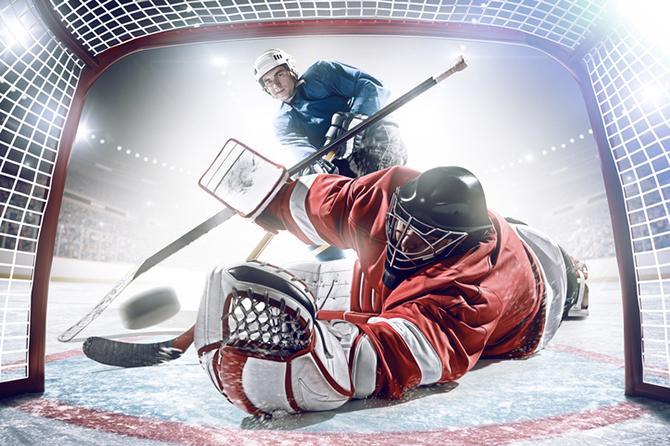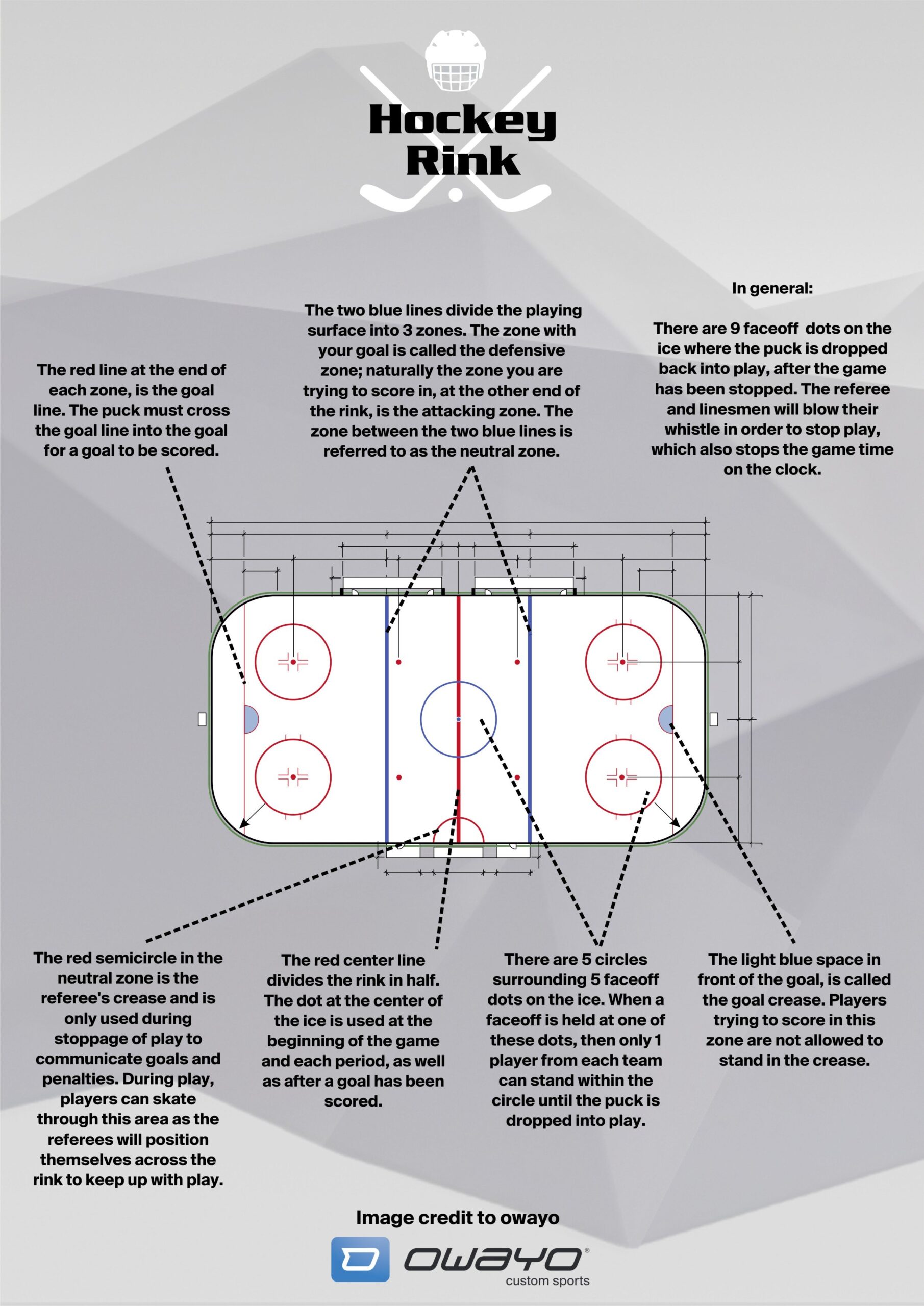Ice Hockey Rules! Ice hockey is played with six players per team on the ice. The objective is to score goals by shooting the puck into the opponent’s net.
Ice hockey is a fast-paced, physical sport played on an ice rink. Each team consists of six players: three forwards, two defensemen, and a goalie. Players use sticks to control, pass, and shoot the puck. The game comprises three periods, each lasting 20 minutes.
Teams aim to score more goals than their opponents. Body checking is allowed, adding to the sport’s intensity. Penalties are given for rule violations, leading to power plays. Ice hockey requires speed, skill, and teamwork, making it a thrilling sport to watch and play.
Introduction To Ice Hockey
Ice Hockey is a fast-paced and thrilling sport. It combines speed, skill, and strategy. This sport is played on an ice rink. Two teams compete to score goals using a puck. Each team uses sticks to control the puck. Ice Hockey has a rich history and a global fanbase.
Brief History
Ice Hockey originated in the 19th century. It began in Canada. Early games were played on frozen ponds. The first official rules were created in 1875. Montreal hosted the first indoor game. The sport quickly spread across North America. By the early 20th century, it had reached Europe.
| Year | Event |
|---|---|
| 1875 | First indoor game in Montreal |
| 1893 | Stanley Cup introduced |
| 1920 | Ice Hockey debuted in the Olympics |
Popularity And Reach
Ice Hockey is popular worldwide. It is especially loved in Canada, the USA, and Europe. The NHL is the top professional league. It features teams from the USA and Canada. International competitions attract millions of viewers. The Winter Olympics showcase the best talents.
- Canada has the most passionate fans.
- Many countries have their own leagues.
- World Championships are held annually.
Ice Hockey’s reach extends beyond its origins. Its popularity continues to grow. More kids are playing Ice Hockey today. This ensures the sport’s bright future.
Basic Equipment
Ice hockey is an exciting and fast-paced sport. Players need specific equipment to play safely and effectively. Below are the essential items every player must have:
Skates
Ice hockey skates are crucial for players. Skates have sharp blades that help players glide on the ice. They need to fit snugly for better control and speed.
- Boot: Provides ankle support and comfort.
- Blade: Made of steel, helps with quick movements.
- Holder: Connects the blade to the boot.
Sticks
Hockey sticks are used to control and shoot the puck. They come in different sizes and materials to suit each player’s needs.
| Part | Description |
|---|---|
| Shaft | The long part players hold. |
| Blade | The flat part used to hit the puck. |
Protective Gear
Players wear protective gear to stay safe during the game. This gear includes:
- Helmet: Protects the head from injuries.
- Shoulder pads: Guards the upper body.
- Elbow pads: Shields the elbows from falls.
- Gloves: Protects hands and provides grip.
- Shin guards: Safeguards the lower legs.
- Mouthguard: Protects teeth and gums.
The Ice Rink
The ice rink is the stage where the thrilling game of ice hockey unfolds. Understanding its layout is crucial for both players and fans. This section will explain the dimensions and zones of the ice rink.
Rink Dimensions
The standard ice hockey rink is rectangular. It is 200 feet long and 85 feet wide. The corners of the rink are rounded.
| Dimension | Measurement |
|---|---|
| Length | 200 feet |
| Width | 85 feet |
| Corner Radius | 28 feet |
The rink is surrounded by boards. These boards are usually 4 feet high. The boards keep the puck in play and protect the fans.
Zones And Lines
The ice rink is divided into three main zones:
- Defensive Zone: The area nearest to a team’s goal.
- Neutral Zone: The middle area of the rink.
- Offensive Zone: The area nearest to the opponent’s goal.
Several lines mark the rink:
- Center Line: Splits the rink into two halves.
- Blue Lines: Divide the rink into zones.
- Goal Lines: Located at each end, marking the goals.
The center line is crucial for face-offs. The blue lines help determine offsides. The goal lines are used to judge goals.
These zones and lines make the game organized. They help in gameplay and rule enforcement.
Team Composition
Understanding team composition in ice hockey is essential. Each team consists of six players on the ice. This includes one goalie, two defensemen, and three forwards. Knowing their roles can help you enjoy the game more.
Player Positions
Players have specific positions in ice hockey. Here is a breakdown:
| Position | Number of Players | Area of Play |
|---|---|---|
| Goalie | 1 | Goal area |
| Defensemen | 2 | Defensive zone |
| Forwards | 3 | Offensive zone |
Roles And Responsibilities
Each player has unique roles:
- Goalie: Protects the goal and stops pucks.
- Defensemen: Block opponents and clear the puck.
- Forwards:
- Center: Leads the attack and wins face-offs.
- Left Wing: Scores from the left side.
- Right Wing: Scores from the right side.
Game Duration
Ice hockey is a fast-paced sport with specific rules on game duration. Understanding these rules is key to enjoying the game. Let’s explore the duration of an ice hockey game.
Periods
An ice hockey game consists of three periods. Each period lasts 20 minutes. Between periods, there is a 15-minute intermission. This allows players to rest and the ice to be resurfaced.
During these periods, the clock stops for various reasons. These include penalties, goals, and official time-outs. This ensures that the game flow remains fair and exciting.
Overtime Rules
If the game is tied after the three periods, overtime occurs. Overtime rules can vary based on the league.
In the NHL regular season, overtime is a 5-minute period. It is played with three skaters per team, known as 3-on-3. If no team scores, the game moves to a shootout.
During the playoffs, overtime periods are 20 minutes each. They are played with five skaters per team. The game continues until a team scores, known as sudden death.
| Scenario | Overtime Duration | Skaters Per Team |
|---|---|---|
| Regular Season | 5 minutes | 3 skaters |
| Playoffs | 20 minutes | 5 skaters |
In other leagues, overtime and shootout rules might differ. Always check the specific league rules to know more.

Credit: www.owayo.com
Starting The Game
The excitement in ice hockey begins right from the start of the game. Understanding how the game starts is key for fans and players alike. The initial moments can set the tone for the entire match.
Face-offs
A face-off occurs at the start of each period and after each goal. Two players face each other at the center ice. The referee drops the puck between them. Both players attempt to gain control of the puck.
Puck Drop
The puck drop is a crucial part of the face-off. The referee holds the puck waist-high before dropping it. Players must wait until the puck hits the ice to make their move. Quick reactions and strategy are essential at this moment.
| Event | Location | Participants |
|---|---|---|
| Start of Game | Center Ice | Two Players |
| After Goal | Center Ice | Two Players |
| Penalty | Nearest Face-off Spot | Two Players |
During the game, face-offs also happen at specific spots. These spots include the blue lines and near the goals. The referee ensures that players follow rules during the face-off. Breaking these rules results in penalties and delays.
Understanding the start of the game helps in appreciating ice hockey’s fast pace. Every face-off and puck drop brings a new chance for teams to take control.
Scoring
Ice hockey is a thrilling sport that keeps fans on the edge of their seats. The most exciting part is scoring goals. Knowing how goals and assists work is crucial for understanding the game better.
Goals
In ice hockey, a goal is scored when the puck completely crosses the goal line. The puck must go between the goalposts and under the crossbar. Both the referee and video replay can confirm the goal.
Goals can be scored in many ways. A player can shoot, deflect, or even tap the puck into the net. Here are the key points to remember:
- Shot: A player uses their stick to shoot the puck.
- Deflection: The puck changes direction off a player’s stick or body.
- Rebound: The puck bounces off the goalie and is scored.
Assists
An assist is credited to the player who helps set up the goal. Up to two players can earn an assist on a single goal. Assists are vital for team play and show how players support each other.
Here is how assists are recorded:
- The player who passes the puck to the goal scorer.
- The player who made the pass before the final pass.
Assists highlight the teamwork needed in ice hockey. They show how each player contributes to the goal.
Penalties
Ice hockey is an exciting and fast-paced game. However, players must follow strict rules. Breaking these rules results in penalties. Penalties help maintain a fair and safe game. They come in various forms, each with different consequences.
Minor Penalties
Minor penalties are common in ice hockey. These penalties usually last for two minutes. During this time, the offending player sits in the penalty box. The team must play with one less player on the ice. Minor penalties include:
- Tripping
- Hooking
- Slashing
- Holding
- Interference
Minor penalties can change the game’s momentum. Teams must be careful to avoid them. Repeated minor penalties can lead to further discipline.
Major Penalties
Major penalties are more severe than minor penalties. These penalties last for five minutes. The offending player must sit in the penalty box for the full duration. Major penalties include:
- Fighting
- Boarding
- Checking from behind
- Spearing
- High-sticking causing injury
Major penalties can have a significant impact. The team plays shorthanded for five minutes. This can lead to multiple goals by the opposing team. Coaches and players must avoid major penalties at all costs.
Understanding penalties is crucial for players and fans. It helps keep the game fair and exciting. Knowing the differences between minor and major penalties enhances the viewing experience.
Key Rules
Ice hockey is an exciting sport with fast-paced action. Understanding the key rules is essential for players and fans. Here are some crucial rules that every ice hockey enthusiast should know.
Offside
The offside rule ensures fair play and keeps the game organized. A player is considered offside if they enter the attacking zone before the puck. The attacking zone is the area past the opponent’s blue line.
If a player is offside, the referee stops the game. The face-off then happens in the neutral zone. This rule prevents players from camping near the opponent’s goal.
Icing
Icing is another critical rule to understand. A team commits icing when they shoot the puck from their side of the red line and it crosses the opponent’s goal line without being touched.
When icing occurs, the referee stops the game. The face-off then takes place in the offending team’s zone. This rule encourages teams to make controlled passes rather than just shooting the puck down the ice.
| Term | Definition |
|---|---|
| Offside | Entering the attacking zone before the puck. |
| Icing | Shooting the puck across the opponent’s goal line from behind the red line without it being touched. |

Credit: m.youtube.com

Credit: www.bigrapidshockey.org
Frequently Asked Questions
What Are The Basic Rules Of Ice Hockey?
Ice hockey has six players per team on the ice. The objective is to score by shooting the puck into the opponent’s net. Players can pass, shoot, and skate, but certain actions like high-sticking, tripping, and interference are prohibited.
How Long Is An Ice Hockey Game?
An ice hockey game consists of three periods, each lasting 20 minutes. If the game is tied, it may go into overtime. Penalties and stoppages can extend the total duration.
What Is Offside In Ice Hockey?
Offside occurs when a player enters the opponent’s zone before the puck. The play stops, and a faceoff happens outside the blue line.
What Is A Power Play In Ice Hockey?
A power play happens when a team has more players on the ice due to an opponent’s penalty. It provides a significant scoring advantage.
Conclusion
Understanding ice hockey rules enhances your appreciation of the game. Whether you’re a player or fan, knowing the rules is essential. It helps you enjoy the sport more deeply and engage in discussions. So, dive into the world of ice hockey and experience the thrill firsthand.
Happy watching and playing!




